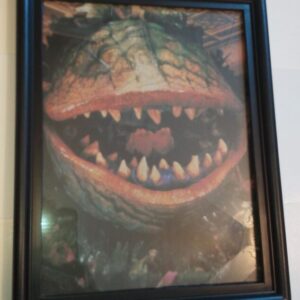Description
Major Arnold Toht, an interrogator for the Gestapo, who tries to torture Marion Ravenwood for the headpiece of the Staff of Ra. He dies by the Ark’s supernatural powers. Lacey was cast as he reminded Spielberg of Peter Lorre. Aware of the supernatural danger of looking at the opened Ark, Indy warns Marion to close her eyes. Meanwhile, the apparitions suddenly morph into “angels of death”, and all of the Nazi soldiers, along with Belloq and Toht, are gruesomely killed. The melting of Toht’s head was done by exposing a gelatine and plaster model of Ronald Lacey’s head to a heat lamp with an under cranked camera, while Dietrich’s crushed head was a hollow model from which air was withdrawn. Raiders of the Lost Ark (later marketed as Indiana Jones and the Raiders of the Lost Ark) is a 1981 American fantasy-adventure film directed by Steven Spielberg, produced by George Lucas, and starring Harrison Ford. It was the first installment in the Indiana Jones film franchise to be released, though it is the second in internal chronological order. It pits Indiana Jones (Ford) against a group of Nazis who are searching for the Ark of the Covenant which Adolf Hitler believes will make their army invincible. The film co-stars Karen Allen as Indiana’s former lover, Marion Ravenwood; Paul Freeman as Indiana’s nemesis, French archaeologist René Belloq; John Rhys-Davies as Indiana’s sidekick, Sallah; Ronald Lacey as Gestapo agent Arnold Toht; and Denholm Elliott as Indiana’s colleague, Marcus Brody. The film originated from Lucas’ desire to create a modern version of the serials of the 1930s and 1940s. Production was based at Elstree Studios, England; but filming also took place in La Rochelle, Tunisia, Hawaii, and California from June to September 1980. Released on June 12, 1981, Raiders of the Lost Ark became the year’s top-grossing film and remains one of the highest-grossing films ever made. It was nominated for nine Academy Awards in 1982, including Best Picture, and won four (Best Art Direction, Best Film Editing, Best Sound, Best Visual Effects) and a fifth Special Achievement Award for its Sound Effects Editing. The film’s critical and popular success led to three additional films, Indiana Jones and the Temple of Doom (1984), Indiana Jones and the Last Crusade (1989), and Indiana Jones and the Kingdom of the Crystal Skull (2008), the television series The Young Indiana Jones Chronicles (1992–1996), and 15 video games as of 2009. In 1999, the film was included in the U.S. Library of Congress’ National Film Registry as having been deemed “culturally, historically, or aesthetically significant”.
Frame is shrinkwrapped until time of purchase. Ships boxed with packing peanuts.
THE PERFECT GIFT!
Related products
-


Little Shop of Horrors Pin-up # 2 FRAMED Audrey II
$44.99 Add to cart -


Legend Pin-up # 2 FRAMED Tim Curry Satan aka Lord Darkness
$59.99 Add to cart -


Batman Pin-up #123 FRAMED Christian Bale Police Car Dark Knight Rises Movie The
$99.99 Add to cart -


Ghostbusters Pin-up # 1 FRAMED Sigourney Weaver The Gatekeeper
$49.99 Add to cart



